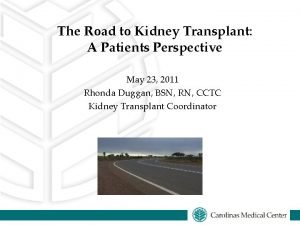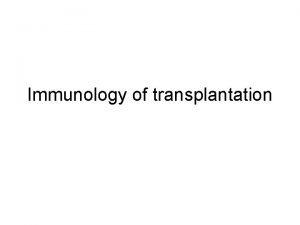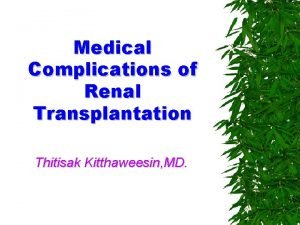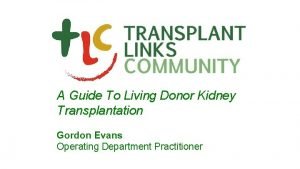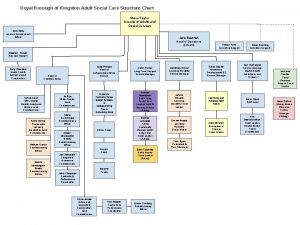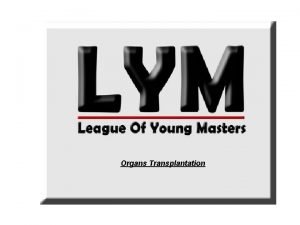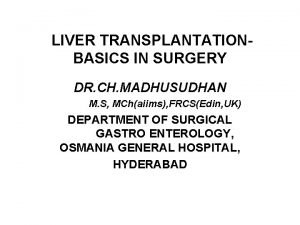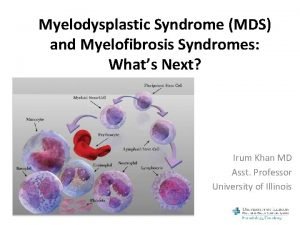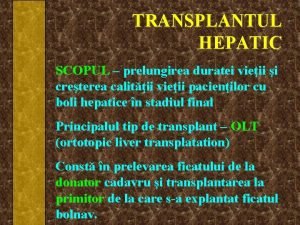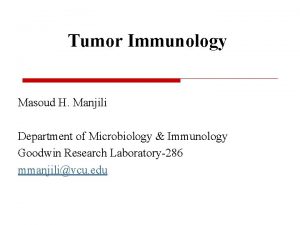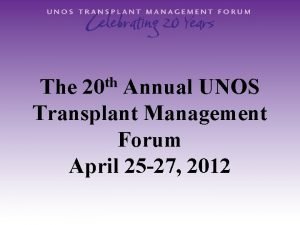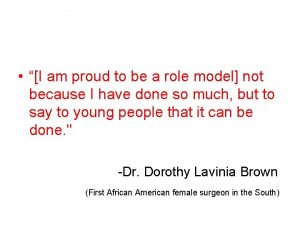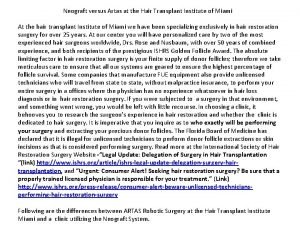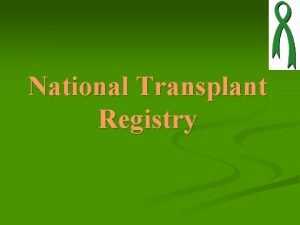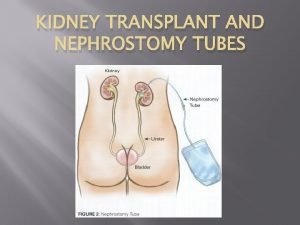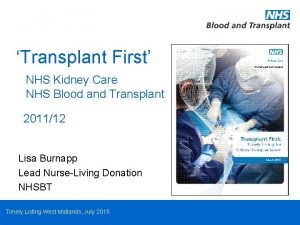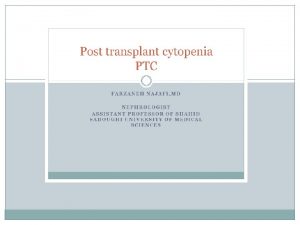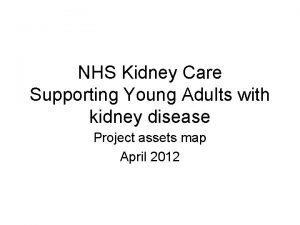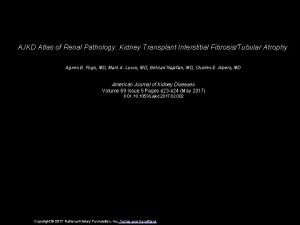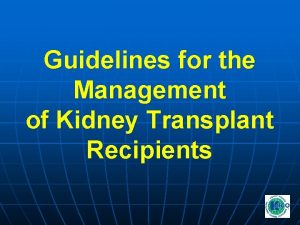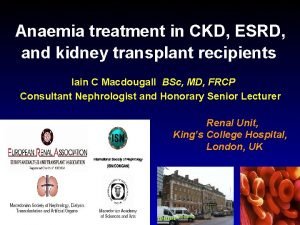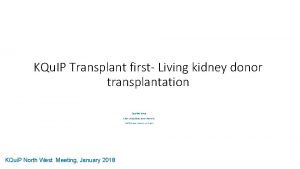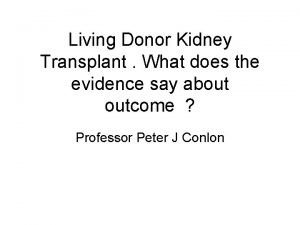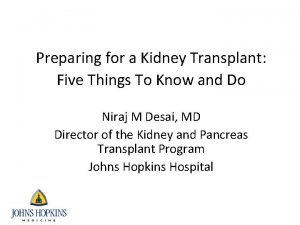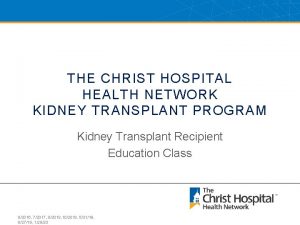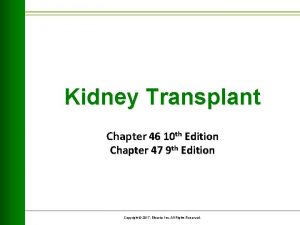Overview of care of the adult kidney transplant












































- Slides: 44

Overview of care of the adult kidney transplant recipient 신장내과 강혜란

Introduction § § § Kidney transplantation : Treatment of choice for end-stage renal disease Patients require close follow-up after transplantation since they are on complex immunosuppressive regimens that render them susceptible to infection, malignancy, and cardiovascular disease (CVD) In addition, patients often have multiple comorbidities due to, or as a cause of, their underlying end-stage renal disease

Routine follw-up and labolatory monitoring

Management of immunosuppression § Immunosuppression therapy § Induction therapy § started either pre- or intraoperatively § biologic antibodies, calcineurin inhibitors (CNIs), antimetabolites or antiproliferative agents, and glucocorticoids § Maintenance therapy § steroids, CNIs, and an antiproliferative or antimetabolite agent, such as azathioprine or mycophenolate mofetil § glucocorticoid-free protocols § beneficial impact on blood pressure, glycemic control, bone disease, and lipid profiles § increase the risk of chronic allograft nephropathy -> generally continue low-dose glucocorticoids indefinitely among most patients

Management of immunosuppression § Immunosuppression therapy § The CNIs used in transplantation are tacrolimus and cyclosporine § Cyclosporin § trough concentrations (12 hours postdose) : poor correlation § two-hour postdose cyclosporine level (C 2) § higher C 2 concentrations : associated with decreased acute rejection rates in the first year § Recommended C 2 target concentrations are: § 800 to 1000 ng/m. L in months 1 to 3 after transplantation § 400 to 600 ng/m. L for subsequent months

Management of immunosuppression § Immunosuppression therapy § Tacrolimus § target : whole-blood trough concentrations § first three months : 8 - 12 ng/m. L -> 3 - 7 ng/m. L § dosing and levels may be affected by polymorphisms of the multidrug resistance-1 (Pglycoprotein [PGP]) and CYP 3 A 5 genes § many centers have attempted to use even lower levels of CNIs § antiproliferative agents such as mycophenolate mofetil/sodium or mammalian target of rapamycin (m. TOR) inhibitors ; sirolimus/everolimus may allow the safe reduction of CNIs, as does the use of belatacept § After 6 to 12 months, immunosuppression regimens are generally stably maintained

Management of immunosuppression

Management of immunosuppression § Toxicity associated with common immunosuppressive regimens § CNIs § Hirsutism, alopecia, neurologic disturbances, insomnia, hypertension, acute and chronic renal dysfunction, electrolyte abnormalities, posttransplant diabetes mellitus, hyperlipidemia, malignancies, and anemia § Mycophenolate – Gastrointestinal disturbances § Sirolimus/everolimus – Pulmonary edema, hypertension, poor wound healing and joint pain, anemia, edema, and hypertriglyceridemia § Azathioprine – Leukopenia, hepatitis, and anemia

Management of immunosuppression § Abnormal calcineurin inhibitor concentrations § CNI toxicity can cause kidney injury and hypertension § The prolonged use of CNIs may cause permanent fibrosis in the kidney -> CNI concentrations should be checked at regular intervals § An elevated CNI concentration § § the blood was drawn at the correct time the patient taking the incorrect dose or a change in preparation of the immunosuppression agent administration of a drug or substance that interferes with the metabolism of CNIs Inflammation of the bowel (diarrhea) : concentrations of tacrolimus, but not cyclosporine § Low CNI concentrations § another medication that influences the metabolism of CNI § Noncompliance § Persistently low levels may result in rejection

Common medical problems following transplant § Renal dysfunction § Increased creatinine § Nearly all patients have a decreased GFR, compared with normal native kidney function, following transplantation § The baseline creatinine following transplantation tends to be higher than 1. 1 mg/d. L (97 micromol/L) for most patients, equivalent to an estimated GFR less than 60 m. L/min per 1. 73 m 2 § Reasons for the modest decrease in GFR § the transplantation of a single kidney § ischemic injury (especially in the case of deceased-donor kidneys) § the use of expanded-criteria donors § the use of calcineurin inhibitors (CNIs), which cause vasoconstriction

Common medical problems following transplant § Renal dysfunction § Increased creatinine § The possible causes of the increased creatinine include: § Prerenal (volume depletion due to vomiting or diarrhea) § Postrenal (obstruction) § Calcineurin nephrotoxicity § Allograft rejection § Recurrence of glomerulonephritis § De novo renal diseases such as acute tubular necrosis due to sepsis or nephrotoxins § Drug-induced interstitial nephritis § Infection including pyelonephritis or human polyomavirus type BK-associated interstitial nephritis § Renal artery stenosis

Common medical problems following transplant § Renal dysfunction § Increased creatinine § An extensive history and physical exam § Medications should be reviewed : dose changes, addition of new medications, herbal supplements § The immunosuppressive regimen should be reviewed § Laboratory investigation § serum cyclosporine or tacrolimus level § a urinalysis to exclude infection or new glomerular or interstitial disease § a blood or urine BK-viral load to exclude to BK reactivation : virus-associated interstitial nephritis or nephropathy § A renal ultrasound : exclude obstruction § If there is still no explanation for the increased creatinine, a renal biopsy should be performed to determine the cause of the acute kidney injury

Common medical problems following transplant § Renal dysfunction § Moderately increased albuminuria (microalbuminuria) § Mild proteinuria : decreased long-term graft function and is associated with mortality § should be monitored by measuring the protein-to-creatinine ratio in a random urine sample for recurrence of glomerular diseases : Ig. A nephropathy, FSGS, and diabetic nephropathy § also suggest acute allograft rejection or transplant glomerulopathy § also suggest cardiovascular disease § A renal biopsy may be necessary to determine the cause of proteinuria § most patients whose protein excretion > 1 g/day

Common medical problems following transplant § Renal dysfunction § Renal biopsy § usually performed in the setting of some evidence of allograft dysfunction, such as an elevated serum creatinine, decreased urine output, or worsening proteinuria § The risks of an allograft biopsy § bleeding, damage to other organs, infection, and loss of allograft § reported a very low major complication rate (including transfusion requirement and catheterization) : 0. 4 - 1. 0 % with only one graft lost in approximately 2500 biopsies

Common medical problems following transplant § Hypomagenesemia § common after transplantation § due to magnesium wasting caused by calcineurin-induced downregulation of renal expression of Mg(2+) channel, TRPM 6 § play a role in development of posttransplant diabetes and CNI nephrotoxicity § patients with severe hypomagnesemia may be symptomatic (weakness) and are at risk of cardiac arrhythmias

Common medical problems following transplant § Diabetes mellitus § Many patients develop diabetes mellitus following a renal transplant § Posttransplant diabetes (PTDM) -> new-onset diabetes after transplantation (NODAT) § Reasons for relatively high incidence of NODAT include the following: § The new kidney metabolizes and excretes insulin more efficiently than the failing native kidneys § The transplanted kidney is gluconeogenic § The immunosuppression regimen is diabetogenic § Preexisting risk factors (such as genetic risk factors or metabolic syndrome) predispose patients to developing diabetes

Common medical problems following transplant § Diabetes mellitus § most commonly develops within the first few months posttransplant , although there is continued risk for the life of the patient and allograft § FBS weekly for the first four weeks § FBS and Hb. A 1 C are checked at 3, 6, and 12 months -> annually thereafter § Most patients will require pharmacologic treatment of hyperglycemia in addition to diet modifications, exercise, and weight loss § For some patients, the immunosuppression regimen may be altered or reduced to minimize the risks of diabetic complications § Steroids, CNIs, and mammalian target of rapamycin (m. TOR) inhibitors can all adversely affect blood glucose levels

Common medical problems following transplant § Infectious diseases § major cause of death following renal transplantation § transplant patients are susceptible to both common and opportunistic infections § most likely to occur between the first and third months following transplant since immune suppression is at its maximum : induction therapy, pulse steroids § However, the risk of infection persists as long as the patient is on immunosuppressive medication

Common medical problems following transplant § Infectious diseases § Common infections § occur in transplant patients who are six months or more from transplant § Upper respiratory infection § Urinary tract infection § most common bacterial infections occurring in the renal transplant recipient § Opportunistic infections § Common pathogens that affect renal transplant recipients § cytomegalovirus (CMV) § polyomavirus (BK and JC virus) § increasingly rarely, Pneumocystis jirovecii pneumonia (PCP)

Common medical problems following transplant § Vaccinations § Patients should not be given any live or live attenuated vaccines after transplantation § Inactivated vaccinations are considered to be safe

Common medical problems following transplant § Anemia § inevitably anemic immediately before and after renal transplantation : due to § surgical blood loss and inflammation § delayed graft function § induction and immunosuppression therapy causing bone marrow suppression § abrupt cessation of erythropoietin-stimulating agents § resolves within 6 - 12 months after transplantation (or earlier among patients who are not iron deficient or have graft dysfunction) § redevelop late in the transplant period in association with § § § decreased transplant function immunosuppressive drugs antiviral agents Infections use of angiotensin-converting enzyme inhibitors (ACEIs) or angiotensin receptor blockers (ARBs)

Common medical problems following transplant § Cardiovascular disease § CVD : major cause of death, graft loss in diabetic renal transplant recipients § Risk factors § end-stage renal disease, diabetes, hypertension, anemia, and obesity § caused or exacerbated by immunosuppressive medications § Hypertension § definition : blood pressure greater than 140/90 § reported in 50 - 80 % of the kidney transplant population (130/80 ) § associated with worse long-term graft outcome § CNIs and steroids contribute to hypertension by causing vasoconstriction and salt retention, weight gain, and a mineralocorticoid effect

Common medical problems following transplant § Cardiovascular disease § Dyslipidemia is common among kidney transplant recipients § a major risk factor for both CVD and reduced renal allograft survival § New-onset or worsening dyslipidemia : sirolimus, CNIs, and steroid use § K/DOQI : all adult and adolescent transplant recipients be tested for dyslipidemia (total cholesterol, LDL, HDL, and triglycerides) within six months of transplant, at one-year posttransplant, and annually thereafter § Obesity § 50% of transplant patients § lifestyle modification : diet and exercise § If safe, reduction in the dose of steroids should also be considered § little evidence that reducing chronically administered steroid doses will result in weight loss, and late steroid withdrawal may be associated with development of subclinical rejection

Common medical problems following transplant § Malignancy § approximately 3 times more likely to develop cancers than the general population § routine cancer screenings as those recommended for the general population

Common medical problems following transplant § Bone metabolism and disease § Associated factors : § pretransplant renal osteodystrophy § steroids, calcineurin inhibitors § incomplete resolution of hyperparathyroidism § calcium, and vitamin D deficiencies § should be regularly monitored for hyperparathyroidism, vitamin D deficiency, hypocalcemia, and hyperphosphatemia

Common medical problems following transplant § Bone metabolism and disease § Tacrolimus : increase urinary phosphate loss -> Ca, P monitoring § Vitamin D deficiency and osteopenia/osteoporosis are common -> recommend routine calcium and vitamin D supplementation for transplant recipients (hypercalcemia d/t not resolving secondary hyperparathyroidism ) § Some clinicians monitor bone mineral density in the renal transplant recipient § no reliable studies (low BMD is predictive of adverse outcomes ) § the optimal treatment for transplant recipients who have abnormal or worsening bone mineral density studies is not known

Common medical problems following transplant § Pregnancy § Infertility : common among patients with end-stage renal disease § Fertility is usually improved within just a few months after renal transplantation § Pregnancy in a transplant recipient : given the multiple risk factors for both the mother and the developing fetus § The American Society of Transplantation Consensus Opinion states that the patient can safely proceed with pregnancy providing the following conditions are met § Graft function is optimal, defined as a serum creatinine <1. 5 mg/d. L, with <500 mg/24 hour protein excretion § There are no concurrent fetotoxic infections, such as cytomegalovirus (CMV) § The patient is not on known teratogenic or fetotoxic medications § The immunosuppressive regimen is stable at maintenance levels

Common medical problems following transplant § Pregnancy § Risk § risk to the patient and allograft : rejection and allograft failure § changes in metabolism of immunosuppressive medications § increased filtration that occurs during pregnancy § risk to the developing fetus § effect of immunosuppressive medication § transmission of infection

Common medical problems following transplant § Pregnancy § Immunosuppressive medication during pregnancy § Some medication alterations may be necessary prior to conception § mycophenolate mofetil/sodium and the mammalian target of rapamycin (m. TOR) inhibitors, sirolimus/everolimus, be avoided starting six weeks prior to conception -> severe structural malformations § Contraception § The optimal form of contraception for transplant recipients is not known § The American Society of Transplantation Consensus conference suggested the use of progestin-only oral contraceptives and estrogen/progestin formulations, providing blood pressure is adequately controlled

Kidney transplanation & hypophosphatemia

• High frequencies (40– 90%) of hypophosphatemia in the first month after successful kidney transplantation have been reported • It persists for up to 10 years in 25– 30% of transplant patients, with a more favourable bone-mineral metabolic profile and higher e. GFR • associated with superior graft survival

§ Renal P leak § PTH : Hyperparathyroidism § FGF-23 높을수록 § FGFR–Klotho complex § expressed in the distal renal tubule § regulates proximal renal tubular phosphorus reabsorption and 1, 25(OH)2 D production § FGF-23 is a phosphatonin which plays a key role in the pathogenesis of inherited and acquired § § phosphorus wasting disorders FGF-23 : inhibit renal 1 -α hydroxylase, lower calcitriol synthesis, and cause renal phosphorus wasting 1, 25 -dihydroxyvitamin D 낮을수록 § low 1, 25(OH)2 D may impair renal Pi reabsorption and intestinal Pi absorption -> leading to a negative Pi balance § immunomodulatory agents § § Both high doses of steroids and tacrolimus have been implicated as a cause of renal phosphorus wasting in post-renal transplantation bone disease

Tacrolimus : increase urinary phosphate loss



1481336 박** 52/F (001481336) 12 10 8 Calcium 6 inorganic P 4 2 0 6/15 6/22 6/29 7/6 • DM : 2000년 • HTN : 2005년 Tacrolimus Kidney transplantation • ESRD on HD : 2005년 • Kidney transplantation : 2015/6/22 • PTH : 61. 3(4/30), 128 (7/3)



§ 증상유발 기전 § Hypophosphatemia -> resorption증가 -> bone calcium release -> hypercalciuria (calcitriol 합성증가와 관련) => rickets, osteomalacia발생가능 (d/t bone mineralization 감소로) § Red cell 2, 3 -DPG (diphosphoglycerate) 감소 -> Hb의 O 2 affinity증가 -> tissue O 2 release감소 Intracellular adenosine triphosphate (ATP) levels 감소-> cell function감소 § § Sx § § CNS : metabolic encephalopathy, delirium, generalized seizures, and coma Cardiopylmonary : MI, ventricular arrhythmias, respiratory failure due to weakness of the diaphragm Skeletal ; muscle dysfunction include a proximal myopathy (affecting skeletal muscle), dysphagia, and ileus, rhabdomyolysis Hematology: hemolysis





 Disadvantage of kidney transplant
Disadvantage of kidney transplant How does a kidney transplant work
How does a kidney transplant work Kidney donor transplant
Kidney donor transplant Kidney donor transplant
Kidney donor transplant Levels of care primary secondary tertiary
Levels of care primary secondary tertiary Adult care sheffield
Adult care sheffield Adult social care kingston
Adult social care kingston Face transplant
Face transplant Face transplant
Face transplant Embryo transplants gcse biology
Embryo transplants gcse biology Heterotopic liver transplant meaning
Heterotopic liver transplant meaning Allogeneic stem cell transplant
Allogeneic stem cell transplant Meetslk
Meetslk Citomegalvirus
Citomegalvirus Oncogens
Oncogens Acute and chronic
Acute and chronic Diet after bone marrow transplant
Diet after bone marrow transplant Unos transplant management forum
Unos transplant management forum Face transplant
Face transplant Neograft miami
Neograft miami National transplant registry malaysia
National transplant registry malaysia Example of nursing process
Example of nursing process độ dài liên kết
độ dài liên kết Gấu đi như thế nào
Gấu đi như thế nào Sự nuôi và dạy con của hổ
Sự nuôi và dạy con của hổ Thiếu nhi thế giới liên hoan
Thiếu nhi thế giới liên hoan điện thế nghỉ
điện thế nghỉ Một số thể thơ truyền thống
Một số thể thơ truyền thống Trời xanh đây là của chúng ta thể thơ
Trời xanh đây là của chúng ta thể thơ Slidetodoc
Slidetodoc So nguyen to
So nguyen to Tia chieu sa te
Tia chieu sa te đặc điểm cơ thể của người tối cổ
đặc điểm cơ thể của người tối cổ Các châu lục và đại dương trên thế giới
Các châu lục và đại dương trên thế giới Glasgow thang điểm
Glasgow thang điểm Thế nào là hệ số cao nhất
Thế nào là hệ số cao nhất Sơ đồ cơ thể người
Sơ đồ cơ thể người ưu thế lai là gì
ưu thế lai là gì Tư thế ngồi viết
Tư thế ngồi viết Cái miệng xinh xinh thế chỉ nói điều hay thôi
Cái miệng xinh xinh thế chỉ nói điều hay thôi Cách giải mật thư tọa độ
Cách giải mật thư tọa độ Bổ thể
Bổ thể Tư thế ngồi viết
Tư thế ngồi viết Thẻ vin
Thẻ vin Thơ thất ngôn tứ tuyệt đường luật
Thơ thất ngôn tứ tuyệt đường luật
